![]()
![]()
![]()
Use LEFT and RIGHT arrow keys to navigate between flashcards;
Use UP and DOWN arrow keys to flip the card;
H to show hint;
A reads text to speech;
36 Cards in this Set
- Front
- Back
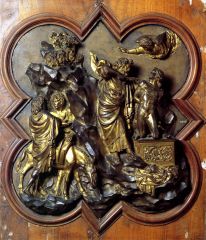
|
Lorenzo Ghiberti Sacrifice of Isaac 1401-03 Design that won Ghiberti the commission of the Baptistery doors. Cast in one piece, exemplary of his technical finesse. Isaac's musculature suggests attention to classical sculpture, landscape flows from BG to FG, shaping space. |
|
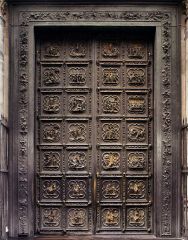
|
Lorenzo Ghiberti North Doors, Baptistery Florence 1403-24 The doors feature scenes from the new testament. Square shapes were very in style at the time. |
|
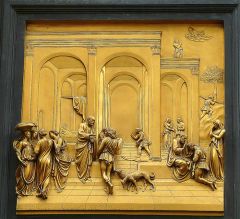
|
Lorenzo Ghiberti East Doors "Gates of Paradise", Baptistery Florence, 1425-52 After the first set was well received Ghiberti went on to do east doors. 28 panels from the Old Testament. Paradise refers to a part of the cathedral, not Eden, this scene is a story about Isaac and his sons, Essau and Jacob. It's a continuous narration unfolding in a single space. Splendor achieved by gilding, significance achieved by subject matter. Elegant and graceful, and "schiaciatto"- low relief carving- provided depth. |
|
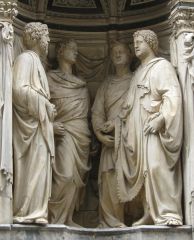
|
Nanni di Banco Four Saints 1409-1416/17 Made for Orsanmichele, commissioned by the sculptor's guild. These are their four patron saints, who were executed for refusing to sculpt the pagan gods in Roman times. They look more like philosophers than sculptors here. Their complete classicism and contraposto was novel at the time. |
|
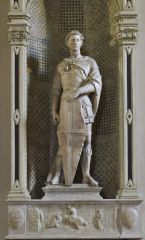
|
Donatello St. George Orsanmichele, Florence 1415-1417 Commissioned by metalworkers guild to fill their niche. George is young and handsome, psychologically intense with living eyes. There is definite life to this sculpture, an effect that was compounded by the real armor that adorned him. At the base there is a schiacciato carving of the slaying of the dragon, which has great depth. |
|
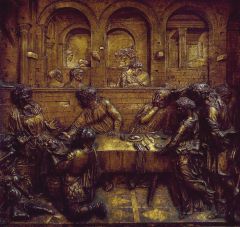
|
Donatello Feast of Herod Baptistery, Siena 1425 Done in schiacciato (low relief), this is the story of st. john the baptist's martyrdom. The frame serves like a window to a space, and the architecture within resembles Brunelleschi. Linear perspective is utilized. This is also a narrative being viewed simultaneously at multiple points in time. We see the progression of St. John's head being brought from the background to the foreground. |
|

|
Donatello David 1420s-1460s Slightly under life size, the first life sized nude produced in europe since antiquity. Middle ages had put a taboo on nudes, associated with pagan idols. Donatello justified nudity saying David put his armor aside to go into battle. This $hit was $hock value. Was displayed in Medici palace. David was a popular figure in Florence, youthful, confident and more powerful than he appeared. |
|
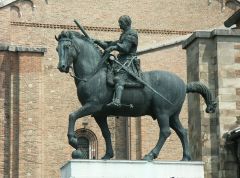
|
Donatello Gattamelata Padua 1445-50 Gattamelata was the nickname of a mercenary general, means "honeycat" ;///w///; awww. Mercenary generals were often honored in this way. this statue bears certain resemblance to ancient statue of Marcus Aurelius. The overall scale of man and beast combined has power and the general sits with dignity. |
|

|
Donatello St. Mary Magdalen 1430-50 Carved from a single block of wood. The sculpture is not spiritual or erotic, rather, Mary's spiritual, ascetic quality is emphasized. There is psychological intensity here, almost expressionist, leaving the body behind to become a being of spirit. Her hair covers her gaunt body. |
|
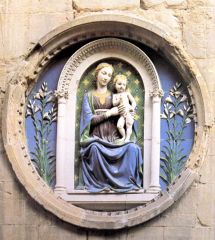
|
Luca della Robbia, Virgin and Child, Orsanmichele, Florence, 1465 Della Robbia developed medium of baked terra cotta with glaze, which is cheap, durable and reproduceable. It is also possible to paint terra cotta to resemble marble. Della Robbia has a sweet, charming style like Ghiberti. His work was widely available and widely appreciated. |
|

|
Andrea del Verrocchio Doubting of Thomas Orsanmichele 1467-83 Commissioned for the Judge's guild, the moment when Jesus sticks doubting Thomas's fingers in his wound to prove the veracity of his rising. Thomas's foot extends outside the niche, connecting the scene inside with the outside world in an inventive way. The artist painted as well and it is clear that he is interested in textures and light vs. dark. Twisting of the body draws viewers in, and there is a contrast in the demeanors of thomas and christ. |
|
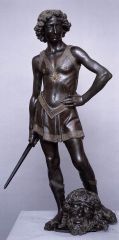
|
Andrea del Verrocchio, David 1475 This David is not as naked, daring or androgynous as Donatello's, but a clear homage. |
|
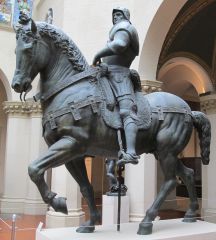
|
Andrea del Verrocchio Equestrian Monument of Colleoni, Venice 1483-88 Horse is smaller, dwarfed a bit by Colleoni's massive presence. Colleoni and horse are both pushing forward, seem brash and haughty and full of energy, apparently accurate to Colleoni's IRL personality, and a contrast to Gattamelata's severe personality. |
|

|
Antonio Pollaiuolo, Hercules and Antaeus 1475 An extremely animated sculpture, limbs flyin everywhere. The subject is mythological, pagan, and this battle is a popular theme in florence. This is an 18" table statue, which is good because it can be picked up and looked at from all angles, which this dynamic subject requires. No precedence for this composition. |
|
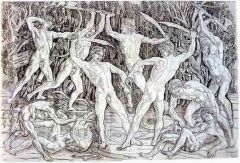
|
Antonio Pollaiuolo Battle of the Ten Nude Men 1465-1470 This super muscular anatomical study came about because Pollaiuolo realized an artist needed a full knowledge of human anatomy. The battle scene was an afterthought, he just needed a context for the nudies. The people look like sacks of walnuts but it's cool nonetheless you go Antonio. |
|
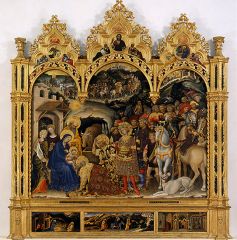
|
Gentile da Fabriano Adoration of the Magi 1423 This sumptuous altarpiece depicts several scenes of the nativity. The flattening effect of so much decorative gold leaf is counteracted by delicate rendering of light and use of light rather than line to deliniate figures. Stacked perspective because 1 pt hadn't been discovered yet. Note foreshortening attempt on pageboy and horses. The magi were important figures to Florence because they were rich men buying expensive gifts for jesus who were looked on as positive figures, Florence was full of bankers who felt a teeny bit hypocritical. the altarpiece itself is valuable as hell, full of gold and lapis lazuli. |
|
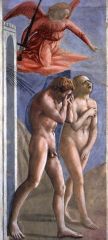
|
Masaccio The Expulsion from Paradise Brancacci Chapel, Florence 1424-27 Made as part of fresco cycle in chapel. In these works Masaccio managed to blend volume of Giotto's figures with a new understanding of drapery and form. Adam and Eve stride in to right, drawing eyes into the chapel. They recognize they Fukked up bad, but their reactions are nuanced. Completion of this chapel was made difficult by expulsion of Brancacci family by Medici, Masaccio's other commissions and later his death...oop... |
|
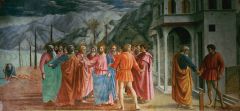
|
Masaccio The Tribute Money Brancacci Chapel, Florence 1424-27 St. Peter is central to this story, which occurs in 3 points in time in the same pictoral scene. Peter appears 3x. All heads are on the same plane- isosephallic arrangement. There is scale and architecture is in 1pt perspective. Cast shadows were rare at the time but are used here, continuous with direction of light coming into chapel from IRL window. No gold foil, just goldenrod paint and perspectivally rendered halos. Masaccio almost humorously shows halo as a literal plate rather than an aura. Peter and Jesus appear in their traditional colors. |
|
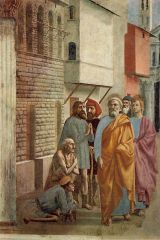
|
Masaccio St. Peter Healing with his Shadow Brancacci Chapel, Florence 1424-27 Cast shadow is a character in this picture. Orthogonals meet at a point outside the picture, making for a very dramatic perspective. the fresco shares a vanishing point with a fresco on the opposite wall! |
|
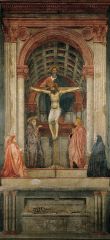
|
Masaccio The Trinity St. Maria Novella, Florence 1425 This fresco depicts a fully realized space that gives the illusion of great depth. Masaccio was obviously aware of Brunelleschi's new system and sort of helped build it. The vanishing point is directly opposite viewer's eye, very low. The patrons appear in profile outside, and below them a skeleton serves as a memento mori. |
|
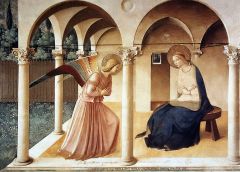
|
Fra Angelico Annunciation Dominican Monastery of San Marco, Florence, 1440s Color is pale and forms are spare, signifies shift from gilded ornamentation to paintings based in geometry of grand and colorful architecture. Figures are doll-like and attractive, super out of whack in scale. |
|

|
Fra Angelico Coronation of the Virgin Dominican Monastery of San Marco, Florence 1440s Again, charming and doll-like in similar vein to Ghiberti. Slightly gothic and slightly classical. Composition is of a large circle set in a square, heads of saints line bottom half of circle. |
|
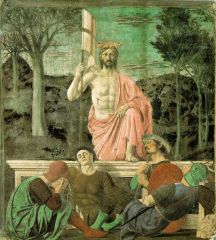
|
Piero Della Francesca Resurrection Borgo San Sepolcro 1463 Guards sleep as Jesus rises. Trees L are leafless, trees R are green, symbolizes death of body vs. landscape of immortal soul. San Sepulcro means "Holy Sepulchre," very important to the citizens of the town. |
|
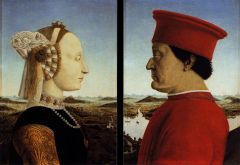
|
Piero della Francesca Portraits of Battista Sforza and Federico da Montefeltro 1472 Double portrait of Duke of Urbino and noble wife. Profile was preferred format of the time, portraits on Roman coins were profile and those were found all over Italy. The Duke hides his bad side, and his wife is resplendent in valuable jewels and fabrics. |
|
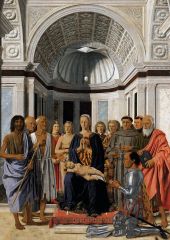
|
Piero Della Francesca Madonna and Child with Saints 1474 Sacra conversazione was a popular subject for altarpieces. Behind empty spot opposite Duke is John the Baptist, patron saint of Battista's family. Battista was dead before this painting was completed, and her absence is communicated with empty space. Sleeping Christ child prefigures the passion, sleep being like death. Egg hangs from ceiling, probably a purely aesthetic choice because Piero liked the play of light on cool stone. The shell is also just for the cool factor. |
|
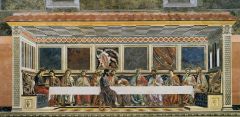
|
Andrea del Castagno Last Supper San Apollonia, Florence 1445-50 Last supper was in the refectory of a convent. Architecture is dramatic and almost garishly bold, while apostles are medatative. The marble in the panel above Judas resembles a lightning strike, in a way. |
|
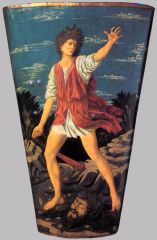
|
Andrea del Castagno David 1450-57 This David was painted on a leather shield. Not for battle, jut ornamental. The hair/drapery is dramatically whipped by wind, stone in sling is in motion. This is a paragone- a comparison, a rivalry of aesthetics between painting and sculpture. |
|
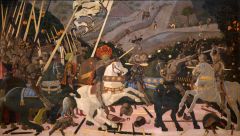
|
Paolo Uccello Battle of San Romano 1438 Emphasis on movement and pageantry. This dude is fuggin addicted to 1 pt perspective. No convenient pavement to create orthogonals, so he makes a grid of shattered lances, swords, a damn corpse, hills in the bg to suggest everything moving towards a vanishing pt. Experimentation with subject in motion. |
|
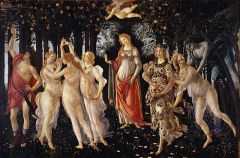
|
Sandro Botticelli Primavera 1482 For Medici family, probably a marriage, a mythological subject, one of first painted in modern age. Zephyr embraces Chloris and tansforms her into Flora. Mercury drives away clouds, Venus stands at center. Mythological subject matter has entered into the catalog of "appropriate stuff." We will see a mix of Christian and Mythological imagery from here on out. |
|
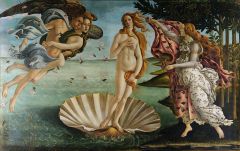
|
Sandro Botticelli Birth of Venus 1485 She nakie. Flora waits to recieve Venus, who is being blown ashore. Exquisite sense of contour and line. This is probably an allegory of the origin of "Celestial venus," source of divine love. Figures are floaty, picture is highly finished and elegant, exemplifies Medici taste. |
|
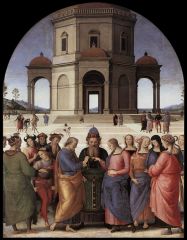
|
Pietro Perugino Marriage of the Virgin 1499-1504 The cathedral in Perugia claimed to have Mary's ring, thus importance of subject. There is 1 pt perspective. orthogonals are in the groundwork. Horizon is visible through door in the back building. |
|
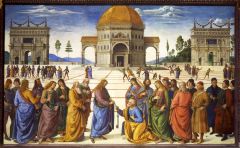
|
Pietro Perugino The Delivery of the Keys 1482 Sistine Chapel Fresco. Commissioned by Pope Sixtus to make frescoes depicting life of moses and christ. This is one of the frescoes. Delivery of keys is gravely symmetrical, but bystanders have highly individualized faces. Left middle distance feat. Tribute money. Right middle, Attempted stoning of christ. 2 Roman Triumphal arches inscriptions compare Sixtus to Solomon, who built temple of Jerusalem. Arches inspired by ideal church in Alberti's treatise on architecture. Mathematically exact perspective. |
|
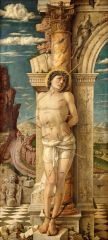
|
Andrea Mantegna Martyrdom of St. Sebastian 1450s Classical ruins lie at Sebastian's feet, he is tied to ruins of Roman Triumphal arch. The perspective in space in bg denotes passage of time. A greek inscription on ruins reads "the work of Andrea," signatures were uncommon at the time. Conflict between past and christian present. Man on a horse in the clouds, clouds represented human imagination and natural representation of forms. |
|
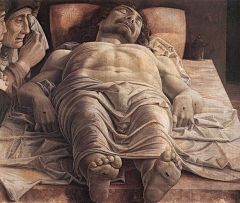
|
Andrea Mantegna, Lamentation over the body of Christ 1480 Very revolutionary extreme foreshortening happy fun time. Meant to display the stigmata on christ's hands and feet. |
|
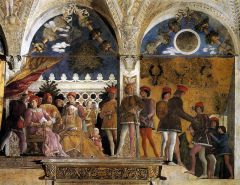
|
Andrea Mantegna, Duke Gonzaga of Mantua and his Court, Ducal Palace, Mantua, 1465-74 Clever illusionism, the fresco leads into the architecture to give the impression of a view of a space in the pictoral plane that connects to the space the viewer is in, The columns in the painting connect to the vaulted ceiling. |
|
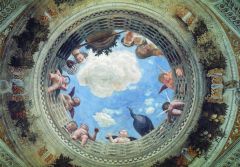
|
Andrea Mantegna Oculus Ducal Palace, Mantua 1465-74 More clever illusionism. This time with 100% more foreshortening! 1 pt perspective apparent. In this one Andrea has a little fun with the people in the room, the cherubs behave mischeviously, some climb or peer over the rail and into the room, they also precariously hoist a barrel right up on the edge. |

